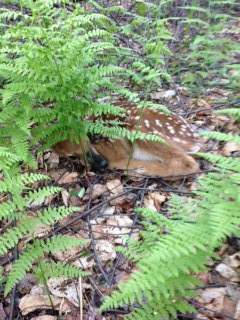Escaping predators when you can barely run can be tricky.
To escape predation white-tailed deer fawns exhibit what is called “hider” behavior. At first moms spend a lot of time bonding with their fawns by licking and cleaning. But soon after birth, moms leave their infant for long periods of time so the fawn can hide.
Some ungulate species, such as bison, caribou, and wildebeest, are “followers” and will not separate from their young at all. Instead these moms keep a close eye on their young and are in constant contact.
White-tailed deer mothers must carefully plan how much time they spend with their fawn to not attract predators. If you have ever seen a newborn fawn you’ll notice they won’t move or make a sound in hopes that you’ll leave them alone!
But don’t worry! Mom is close by and will check on her baby soon.
Around six to eight weeks they begin spending more time together as the fawn gets older. Longer movements occur as the fawn learns its surroundings and some survival skills from mom.
With the help of our new radio-collars, we can now see how often the mother is spending time close to her fawn following birth – within 140 yards. Recently one of our moms crossed a road one too many times and, unfortunately, died but now that we recovered her radio-collar we can see how much time she spent with her fawn in the 23 weeks since its birth!

As you can see this mother spent 50% of her time with her fawn the first week after its birth. In the following weeks she decreased that time so it would not attract the attention of predators. At the six-week mark this mom began spending more time with her fawn while moving around their home range.
At about nineteen weeks this mother-fawn pair decided they were spending too much time together! The fawn was now almost five months old and ventured away from mom for longer. Currently, this little guy is on his own but he is doing just fine.
As our study progresses and more collars come in, we will be able to see if other mother-fawn pairs match this pattern.
-Tess Gingery
Tess Gingery is a graduate student of the Pennsylvania Cooperative Fish and Wildlife Research Unit in the Department of Ecosystem Science and Management at Penn State. She is studying fawn survival and mother-offspring movements for her M.S. degree in Wildlife and Fisheries Science.
